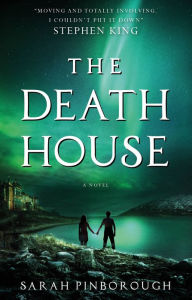The Death House is Disquieting, Atmospheric Sci-Fi
 When I finished Sarah Pinborough‘s new novel The Death House, I had to take a moment to collect my thoughts. Not because it’s particularly twisty or complex— it’s about as straightforward as one can get for a tale of teenagers stuck in a dystopian hospice— but because it comes in quietly and leaves with the emotional impact of a wrecking ball.It slowly builds to its emotional climax, letting the characters drive the plot, keeping the more fantastical elements out of the way, and then it just pushes.
When I finished Sarah Pinborough‘s new novel The Death House, I had to take a moment to collect my thoughts. Not because it’s particularly twisty or complex— it’s about as straightforward as one can get for a tale of teenagers stuck in a dystopian hospice— but because it comes in quietly and leaves with the emotional impact of a wrecking ball.It slowly builds to its emotional climax, letting the characters drive the plot, keeping the more fantastical elements out of the way, and then it just pushes.
Toby was living a fairly normal life until he got the blood test. On a day that should have been perfect, he was told he’d tested positive for the “defective gene,” and a black van came to take him to the Death House. Now, he lives a confined existence with the other defectives, under the watchful eyes of the nurses and the Matron, all of whom want to make their wards’ lives as comfortable as possible…until they get sick, and are spirited away to the sanatorium, never to be seen again. Being admitted is a terminal sentence, but as there’s no escape, the days settle into a kind of routine. Until Clara shows up.
The Death House
The Death House
In Stock Online
Paperback $14.95
Clara is bold, vivacious, and brave, and the only person other than Toby who stays up after lights out. She treats the experience like some kind of adventure, and completely upends life at the (predominantly male) Death House. Suddenly, everything that seemed so certain is up in the air. It’s enough to make someone do something desperate. Something daring. And sometimes all it takes is one something to send things spiraling out of control.
Pinborough’s biggest strength is the way she builds empathy and familiarity into her story. She spends most of her time and energy developing her characters and their relationships. Toby’s narration and interactions with his housemates give us a clear sense of who these people are, and as each new plot tumbler falls occurs, they seem to come alive, which makes it even nastier when bad things start to happen to them. It hurt when they started to get sick or fall to infighting. I was relieved when they triumphed. At one point I desperately wanted two characters just to talk to each other again. The house becomes a known place, and that makes it all the more unsettling when it changes.
But what truly cements the empathy and familiarity is the atmosphere. While there are some tense sequences, the book trades much more on general unease. From the opening pages, it’s clear something is off, and to the author’s credit, we’re only given a few hints what the problem truly is: horror movies are banned, there have been “attacks” by “defectives,” it hasn’t snowed for “a hundred years.” These disquieting nuggets of world-building nugget are dropped here and there, and we’re left to fill in the blanks. It’s more disturbing than if she’d spelled out in detail the true horror at the center of things.
The Death House is a riveting, lightly science fictional look at how a group of people for whom death is a certainty choose to live out their days, with a climax somehow both expected and enough of a sharp shock that I’m still trying to process it.
Clara is bold, vivacious, and brave, and the only person other than Toby who stays up after lights out. She treats the experience like some kind of adventure, and completely upends life at the (predominantly male) Death House. Suddenly, everything that seemed so certain is up in the air. It’s enough to make someone do something desperate. Something daring. And sometimes all it takes is one something to send things spiraling out of control.
Pinborough’s biggest strength is the way she builds empathy and familiarity into her story. She spends most of her time and energy developing her characters and their relationships. Toby’s narration and interactions with his housemates give us a clear sense of who these people are, and as each new plot tumbler falls occurs, they seem to come alive, which makes it even nastier when bad things start to happen to them. It hurt when they started to get sick or fall to infighting. I was relieved when they triumphed. At one point I desperately wanted two characters just to talk to each other again. The house becomes a known place, and that makes it all the more unsettling when it changes.
But what truly cements the empathy and familiarity is the atmosphere. While there are some tense sequences, the book trades much more on general unease. From the opening pages, it’s clear something is off, and to the author’s credit, we’re only given a few hints what the problem truly is: horror movies are banned, there have been “attacks” by “defectives,” it hasn’t snowed for “a hundred years.” These disquieting nuggets of world-building nugget are dropped here and there, and we’re left to fill in the blanks. It’s more disturbing than if she’d spelled out in detail the true horror at the center of things.
The Death House is a riveting, lightly science fictional look at how a group of people for whom death is a certainty choose to live out their days, with a climax somehow both expected and enough of a sharp shock that I’m still trying to process it.
